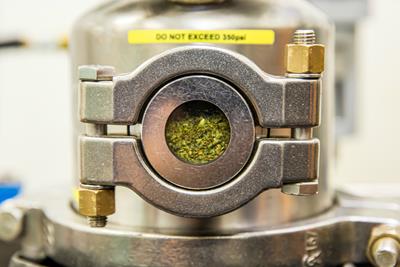
Sunday August 11, 2019
By Paul Barach
 Education
Education
Whether or not you’ve heard of closed-loop extraction, you’ve definitely heard of the concentrates that it creates, such as wax, shatter, and live resin. However, hydrocarbon extraction is a little bit like the internet; most people may have a good idea of what it is without having a great idea of how it works. Luckily, unlike the internet, closed-loop extraction is a fairly simple process that hash innovators have refined tremendously over the years. It’s a bonus for any connoisseur to understand, whether you’re comparing products to buy or thinking about getting into the concentrate game yourself. So, in the spirit of education, let’s dive into what closed-loop extraction is, how it works, and what products can be made from a closed-loop system.
An Overview of Closed-Loop Extraction
Getting cannabinoids like THC from Point A, where they’re inside the plant, to Point B, where they’re in concentrated form, requires several steps. Essentially, raw cannabis flower (sometimes “fresh-frozen” for live resin preparations) the raw flower is sprayed with a pressurized solvent, usually refined butane or propane, which separates the cannabinoid- and resin-producing trichomes from the plant matter. After blasting the plant under high-pressure, what’s left is a layer of sticky brown or dark yellow resin, which is then purged, dried, and processed into its desired form of concentrate.
What separates closed-loop extraction from open blasting is that in closed-loop, the solvent never comes in contact with the outside air. Instead, the solvents are sprayed inside a containment chamber, then recovered by a vacuum pump and returned back into the solvent tank for reuse.
This is an enormous advance, both health-wise and environmentally, over open-blasting methods, which are inefficient, sloppy, and dangerous. Open blasting uses far more chemicals and a larger amount of those impurities and solvents remain in the final product since there is no vacuum pump used to recapture them. The solvents also escape into the atmosphere, which isn’t great for the environment or the health of anyone in close proximity. Speaking of heath, there’s also the small matter that blasting anything with butane or propane in an uncovered area carries a risk of fire and explosion.
How Does Closed-Loop Extraction Work?
Now that you have a basic idea of closed-loop extraction, let’s go into the specifics. Closed-loop extraction requires several pieces of equipment, the number of and complexity of which will vary depending on what you’re trying to make. The most basic setup can run up to $5,000, while a high-quality, commercial-grade setup can run anywhere from $30,000 to $500,000.

We’ll start with a basic set up. Besides the tubes and valves, any closed-loop extraction system begins with a pressurized solvent tank of high-quality, laboratory grade butane or propane. Using a pressurized pump, the solvent is sprayed onto the plant matter in the blasting chamber, which separates the cannabinoid-producing trichomes and terpenes from the rest of the material. The resulting resin is then pumped out of the collection chamber and placed into a vacuum oven for the second step of closed-loop extraction: purging.
Inside the vacuum oven, the chamber is depressurized using the recovery pump. This creates a vacuum which pulls out the residual bubbles of butane or solvent in the still-unfinished concentrate. As these bubbles expand and burst, their toxic gasses are quickly removed from the chamber by the vacuum and captured for reuse. In the final step, the concentrate is heated in the vacuum oven at around 110 degrees Fahrenheit for 3 to 10 hours, which cooks out any lasting residual traces of solvents or other impurities through evaporation. It’s important to note that there are many ways a concentrate can be ‘finished’ into different products after extraction. Some of the steps above vary depending on what the desired end product is and many concentrate labs have their own unique way to make their products.
What Products Can Be Made From A Closed-Loop System?
Most solvent-based concentrates can be made using a closed-loop system. What makes this system the best is the quality of product that can be made. With the correct vacuum oven, blasting chamber, and other recovery systems to extract, THC levels can be as high as 80-90% while keeping the levels of solvents and impurities low.

The majority of products made with closed-loop extraction fall under the heading of Butane Hash Oil (BHO). Products made from BHO have a wide range of consistencies depending on their liquid and air content, which gives them their different names such as budder, crumble, wax, shatter, and live resin. Pure shatter, for example, requires more processing than a budder. To get the light yellow or brown, glassy shatter means extracting all the solvent and impurities from the final product, requiring both a steady vacuum to pull out the solvent and impurities from the product, as well as heat to evaporate residual solvent and clear out any bubbles remaining.
Live resin, containing the most active terpenes, is typically only made in the most high quality closed-loop extractors. Producing high quality live resin requires both freezing the plant material immediately upon harvest as well as placing it in the extractor less than 36 hours after it was placed in refrigeration, then running only chilled solvent over the product. Again, there are many ways and methods to make live resin (and any concentrate for that matter), but the best products all start with a closed-loop extraction system.
Want to add your input on the basics of closed-loop extraction? Share your opinion and expertise in the comments below! Want to learn more about concentrates as a whole? Check out our Comprehensive Guide to Cannabis Concentrates!







